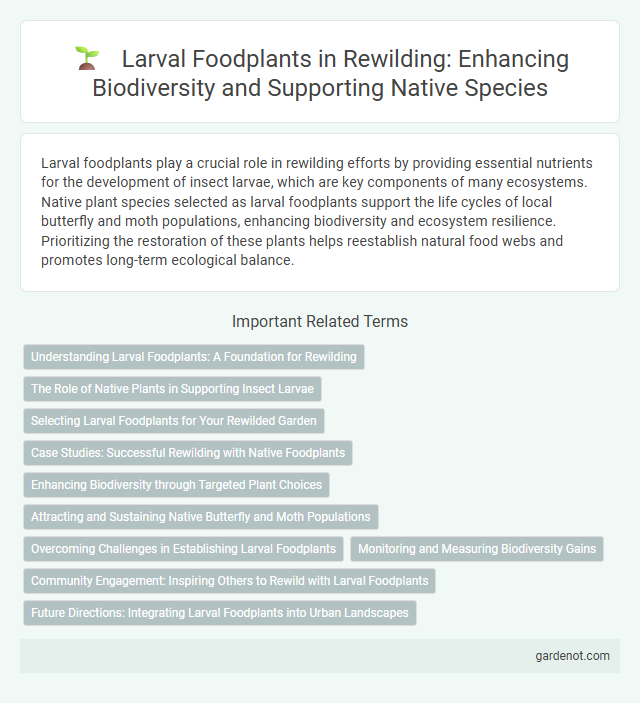Larval foodplants play a crucial role in rewilding efforts by providing essential nutrients for the development of insect larvae, which are key components of many ecosystems. Native plant species selected as larval foodplants support the life cycles of local butterfly and moth populations, enhancing biodiversity and ecosystem resilience. Prioritizing the restoration of these plants helps reestablish natural food webs and promotes long-term ecological balance.
Understanding Larval Foodplants: A Foundation for Rewilding
Larval foodplants serve as critical resources for the survival and development of butterfly and moth larvae, directly influencing biodiversity within rewilded ecosystems. Understanding specific host plants, such as nettles for the Small Tortoiseshell or willows for the Mourning Cloak, enables targeted reintroduction and habitat restoration efforts. Preserving and planting native larval foodplants supports complex food webs and promotes ecosystem resilience during rewilding projects.
The Role of Native Plants in Supporting Insect Larvae
Native plants play a crucial role in supporting insect larvae by providing essential larval foodplants that cater to the specific dietary needs of various butterfly and moth species. These indigenous flora offer the necessary nutrients and chemical compounds required for larval growth and development, ensuring higher survival rates and promoting biodiversity. Incorporating native plant species into rewilding projects fosters healthy insect populations, which are vital for ecosystem functions such as pollination and serving as prey for other wildlife.
Selecting Larval Foodplants for Your Rewilded Garden
Choosing appropriate larval foodplants is essential for supporting caterpillar development and enhancing biodiversity in a rewilded garden. Native plant species like nettles, milkweed, and oak serve as critical food sources for various butterfly and moth larvae, promoting healthy insect populations. Prioritizing plants that cater to local butterfly species ensures effective rewilding by sustaining the entire life cycle of pollinators and other beneficial insects.
Case Studies: Successful Rewilding with Native Foodplants
Case studies of successful rewilding highlight the importance of native larval foodplants such as milkweed for monarch butterflies and native nettles for the red admiral butterfly. Restoration projects that reintroduce these plants have boosted local butterfly populations by providing essential nutrients during larval stages, promoting biodiversity recovery. Monitoring data from rewilded habitats demonstrates enhanced ecosystem resilience and increased pollinator abundance linked to the presence of native larval foodplants.
Enhancing Biodiversity through Targeted Plant Choices
Rewilding projects that prioritize larval foodplants such as milkweed for monarch butterflies or nettles for peacock caterpillars significantly enhance biodiversity by supporting specialized insect species. Selecting native plants with known larval associations promotes the survival of pollinators and other beneficial insects critical to ecosystem stability. Incorporating a diverse array of larval foodplants increases habitat complexity and fosters resilient, interconnected ecological communities.
Attracting and Sustaining Native Butterfly and Moth Populations
Planting native larval foodplants such as milkweed, nettle, and willow supports the complete life cycle of butterflies and moths by providing essential nutrition for caterpillars. These plants enhance habitat quality, increase biodiversity, and promote the regeneration of native butterfly and moth populations in rewilding projects. Ensuring a diverse selection of larval host plants sustains local ecosystems and fosters pollinator resilience.
Overcoming Challenges in Establishing Larval Foodplants
Establishing larval foodplants for rewilding projects requires selecting native species that match the specific dietary needs of local butterfly and moth larvae, ensuring their optimal growth and survival. Overcoming challenges such as soil degradation, invasive species competition, and inconsistent climate conditions involves targeted habitat restoration techniques and adaptive management strategies. Successful establishment enhances biodiversity by supporting robust larval populations and promoting ecosystem resilience.
Monitoring and Measuring Biodiversity Gains
Monitoring larval foodplants is essential for assessing biodiversity gains in rewilding projects, as these plants directly support key insect populations. Measuring the presence and abundance of specific larval host species provides accurate indicators of ecosystem health and species recovery. Data collected through systematic surveys and remote sensing enable targeted habitat management to enhance larval foodplant diversity and promote overall ecological resilience.
Community Engagement: Inspiring Others to Rewild with Larval Foodplants
Larval foodplants play a crucial role in rewilding by supporting the growth and survival of butterfly and moth populations, inspiring communities to connect with native biodiversity. Local workshops and community gardens centered on cultivating these plants foster environmental stewardship and encourage collective action toward habitat restoration. Sharing success stories and educational resources motivates individuals to integrate larval foodplants into urban and rural landscapes, amplifying rewilding efforts.
Future Directions: Integrating Larval Foodplants into Urban Landscapes
Integrating larval foodplants into urban landscapes supports biodiversity by providing essential nutrition for butterfly and moth larvae, fostering pollinator populations. Urban rewilding projects should prioritize native plant species that serve as optimal larval hosts to enhance habitat connectivity and ecological resilience. Research on plant-larvae interactions guides the selection of foodplants that thrive in urban soils and microclimates, ensuring sustainable larval development and population recovery.
Larval foodplant Infographic

 gardenot.com
gardenot.com